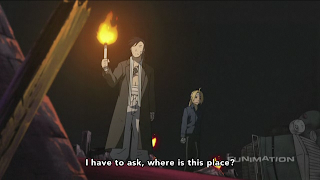Ani-Gamers blogger Ink contributes a weekly column in which he examines the differences between the original Fullmetal Alchemist and its re-telling, Fullmetal Alchemist: Brotherhood. To read previous entries, click here.
Our sincerest apologies for the late article. On Sunday we guarantee we’ll have the next article up, right on time.
Watch Episode 25 – Doorway of Darkness
In the depths of Gluttony’s stomach, we’re privy to some Ishvalan back story. But before we get to that, and some differences therein, there’s an issue to address concerning the roles of homunculi.
In FMA1, these artificial humans started out as 2-dimensional characters, born of alchemists’ infractions against the natural laws, that were nothing more than pawns of a puppeteer. Each shared a name with one of the seven deadly sins (Pride, Envy, Lust, Gluttony, Wrath, Sloth) and had one special ability. None could use alchemy (unless endowed with an alchemist’s appendages), which is why they needed to manipulate human alchemists to bring about their plans. As FMA1 progressed, however, these hate-centric creatures developed a third dimension. They started to exhibit a range of human emotions which they were never supposed to be capable of feeling, mostly love and devotion…they started to develop souls (or at least reasonable facsimiles). The acquired range of emotion provided most of the drama and character development for these creatures, which were growing to be more and more autonomous with each passing episode. So in FMA1, homunculi were creatures that became human…even without the philosopher’s stone.
FMA2’s hate-centric homunculi rally around the same nomenclature and are still puppets of a mysterious (?) mastermind. Each also retains their special ability but also now has a “true form” – usually some surrealistic monstrous apparition appropriate to their name. FMA2 takes every emotion away from the homunculi, save hate/anger; concentrates it; then sets it on fire and lets it loose in a hospital full of newborns. This means that FMA2’s homunculi are underdeveloped characters compared to FMA1, but their presence is one of awe-inspiring nastiness. A wonderful example would be Envy’s true form, complete with tortured howling faces just barely buried under the skin of a large lizard-like creature. We’re privy to this while Envy and Ed/Yao duke it out in the bowels of Gluttony’s stomach, which is truly a world unto itself…one “between reality and truth.” Turns out that Gluttony’s infinite appetite is fueled by the fact that he is a failed experiment of the puppeteer (“Father”), which is a also dimension never addressed in FMA1. Also revealed during this fight is the fact that Envy is the homunculus who, disguised as an Amestrian soldier, shot an Ishvalan child – the event which sparked the Ishvalan war in both series. This differs greatly from FMA1, however, which used Sloth as the tool of chaos and her promotion through the ranks of the Amestrian army (all the way up to Fuhrer’s secretary) as the plot device for Maes Hughes’ death and a huge emotional conflict for Ed/Al.
Other developments that were welcome divergences from FMA1 include Gluttony leading Al (as per his request) to “Father,” the splitting up of Mustang’s team, and the Fuhrer using Hawkeye as leverage against Mustang. The latter two are the most interesting, as FMA1 never gave Mustang any real chink in his armor, or at the very least never took advantage of it – that “it” being the solidarity of Mustang’s team and the devotion shared betwixt himself and Hawkeye. In FMA1, the band of soldiers aimed to take down the state military. By breaking up any possibility of this, FMA2 is letting us know there won’t be any such easy road.

